
How to Deal with Angry Customers Email Templates

This blog will give you tips on how to deal with angry customers along with email templates to handle irritate customers. If you run a SaaS business, you must have had angry customers over calls and email support all the time. But don’t worry, follow these tips and you’ll be able to retain even the most difficult customers.
Let’s first see what causes irritation and frustration in customers. This infographic defines some of the main reasons why customers get upset.
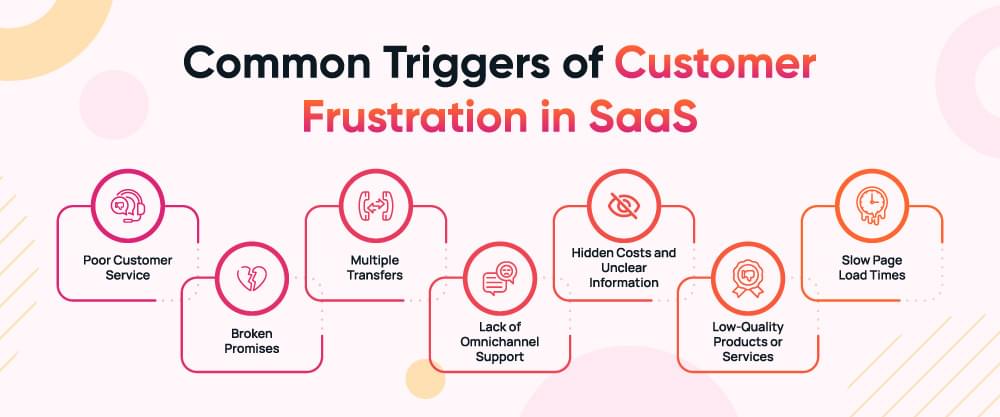
How to Deal with Angry Customers
It is not easy to handle customers’ anger but this is a common experience in customer service. Sometimes, you just have to remain cool, listen to what they have to say, and try to make a turn around. In this guide, we will discuss some simple techniques on how to deal with difficult customers. These are some steps to handle angry customers:
- Know why they are angry
- Stay calm
- Acknowledge customer’s emotions
- Repeat their complain
- Use positive words
- Own the problem
- Build Trust
- Personalize the interaction
- Thank them
Now after building the communication with the customer, you can
- Move to a proper channel
- Think critically
- Explore solutions
- Ask for help
- Share with the team
- Follow up
Know why they are angry
If you’re an experienced support specialist, you must know that when the customer is angry, you need to overlook their anger and rudeness and try to understand why they’re angry. This is the first step towards handeling them.
The fact of the matter is that, a single unhappy customer is likely to complain to 26 other people. The majority of the clients just exit without giving their opinion. That is why when a customer complains, they are giving a second chance to the company to retain the client.
Stay Calm
It is very important to keep our cool when handling an angry client. You need to know that the customer only wants to be heard. This will enable you to understand the problem better since you are not tensed up when listening to the problem.
You can use statements such as:
“I know that this must be annoying”
“I understand why you are having this attitude”
“I can see that this must have been a rather difficult experience for you”
By acknowledging and reflecting the customer’s feelings, you can help the customer to relax.
Consider their affect heuristic.
The affect heuristic is a psychological bias in which decision making depends on peoples’ feelings and not on rational thinking. It will also depend with the current emotional status of the individuals in the situation. And Mood plays a very important role in the decision making process of the individual in question.
This will enable you to be more tolerant when dealing with the person involved in the situation.
Repeat what they said when answering to their query
Repeat what the customer said to you. This means repeating the issue again to the customer. You can say it like:
Okay, so let me get this right, you are unhappy because…”
This ensures the customer that you’re listening to them and understood their issue. This also helps you make sure that you understood their problem right and no detail is missing. This might also give an impression that the issue can be resolved.
Use positive language
Your language should be positive all time, answering back to the customer in any negative way can make things worse.
Here are some examples of positive language:
Rather than saying ‘We can’t do that,’ say ‘This is what we can do. .. ‘
Say instead, “That’s not something we do” with “Let me find out how I am able to assist you even while adhering to our standards.
Instead of saying ‘I don’t know’ try saying ‘Let me check for you’.
Choosing our words carefully can work towards changing the focus of the discussion and may also demonstrate that you are there to assist.
It is Time to Own the Problem
When handling an angry customer the first thing which is very important is to own up to the problem. It’s about taking ownership of the consequences of our actions when it comes to our customers and making sure that every customer experience is smooth and positive.
The study reveal that apology is a better strategy in service recovery than just compensation. To apologize correctly you need to be empathetic and specific , give an explanation, and acknowledge your mistake.
As you know, the simplest and the most affordable method to manage a negative experience is to say sorry to the customer.
Build trust
TTrust is a fundamental issue in the area of customer service for retention and this is where the concept of accountability comes in. It means that you will never compromise the standards of treating the customers equally and fairly.
To build trust you need to make sure that the customer doesn’t face the same issue again in order to retain that client. Here are some ways you can build trust with the customer:
- It is important that one is honest on what led to their problem
- Take responsibility when appropriate
- Only make commitments that you can fulfill
- Stay connected with your customer, don’t leave their mail hanging for days. Even if you have not found the solution yet. Just let them know
This is to note that accountability and responsibility are two sides of the same coin. This is where being accountable differ from being responsible; while being accountable means saying sorry for what one has done, being responsible means that one has to act and act at the right time in order to address the issue of the customer.
Personalize the interaction
Personalized communication is the key to handle an irritate customer. Here’s how you can easily do that
- Using the Customer’s Name
Using the customers’ names when talking to them is one of the most basic tactic to personalize and calm an angry customer. It is not just a check box item, it can be a powerful in changing a conversation into personal one. When you use a customer’s name, you are playing on the psychology of the customer – we are hard-wired to respond when our name is mentioned. This is quite a significant gesture that goes a long way in making the customers appreciate, and in the process create trust and wonderful experiences.
According to SuperOffice survey, only, 5% of businesses apply personalization mainly in the customer service department while this can be easily done by addressing the customers by their names in every interaction whether through phone, live chat or email.
- Adapting Solutions to Client’s Requirements
Customer Personalization is not just limited to using the customer’s name; it is about targeted marketing. By using customer information from purchase history and online behavior, you can understand the customers’ needs and present relative products and services. This being a personalized approach is not only likely to improve the satisfaction of the customers but also their tendency to buy again.
This approach involves:
- Conducting thorough surveys
- Adapting the solutions based on their needs
- Ensuring the clients are followed up on regularly
Here are some personalized email examples.
Product-Related Issues
In case of product related complaints it is important to understand the customers’ issue and provide a solution. First of all, you should apologize for all the negativity that may have been caused to the person. Next, describe what may have happened and give a background information of the occurrence. Here’s a template for product issues.
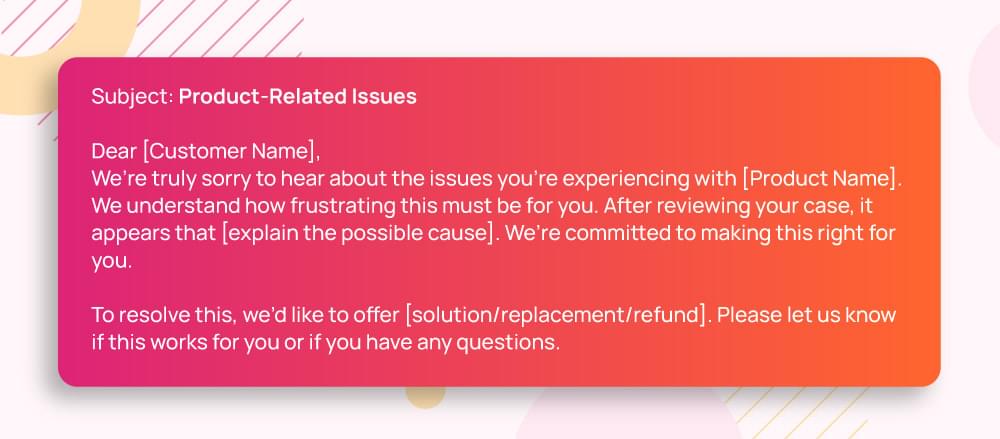
Service Failures
As a reminder, 80% of customers believe that a company’s experience is equally valuable as its products or services.

Billing and Payment Problems
Most of the times, billing problems can be very personal. Be transparent about what happened and offer a clear resolution.
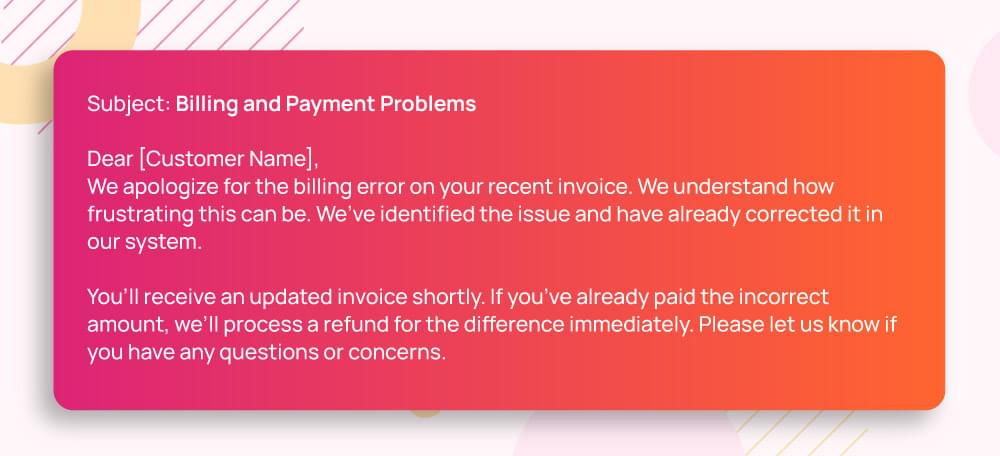
Delivery and Shipping Concerns
When addressing delivery problems, provide specific information about the order status and offer solutions.
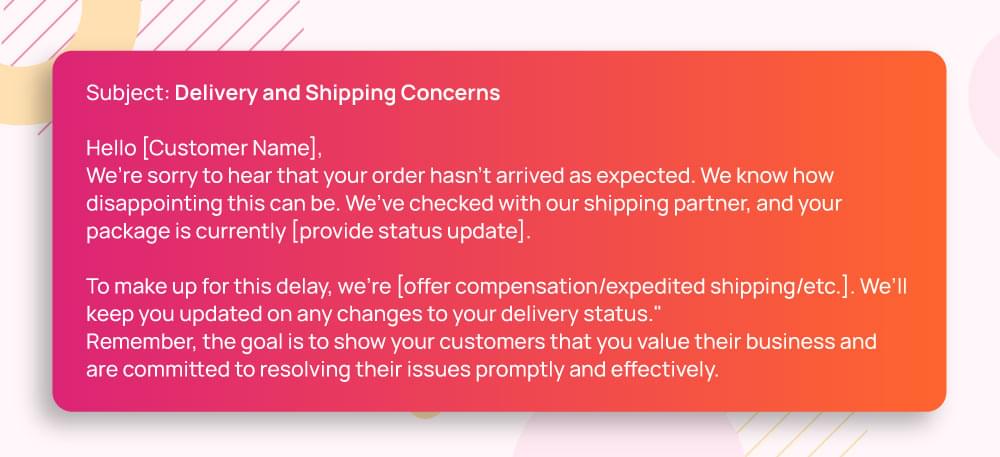
Thank them
It might seem odd to thank an angry customer, but this can be quite effective in calming the difficult customer. Thank them for their patience. This approach makes the person feel that you actually consider his or her opinion and that customer feedback is welcomed.
Go to a proper channel
This is because the current communication channel may not necessarily be the best to address the problem. Don’t be afraid to suggest moving the conversation to a different medium. From using the social network or sending a text message to a direct conversation on the phone. For video call for sharing the screen during the troubleshooting purposes. If one wants to share more information or documents regarding the topic in question, he or she can use email. Select the channel that can help to solve the problem and satisfy the customer in the best way.
Think critically
Now, it comes to where you need to solve the problem. For the issue to be resolved quickly to need to be clear on the issue first. Here are some steps to help you analyze the problem.
- Say out loud and explain each and every step of the process again to the customer.
- Ask for details of the problem.
- Think of the factors that maybe contributing to the issue.
- Analyze that customer’s past complaints to find out the common issues.
Explore solutions
Do not be limited to the first idea that comes in your mind. Take time to explore multiple options:
- Get a feedback from the customer on what may be the possible solutions.
- It is important to look for the quick solutions and the permanent solutions.
- In fact, try to come up with unique solutions to the problems.
- If you cannot meet the needs and expectations of the customer, try to find out what else can be done to meet the customer’s needs.
- Give them several options for solution so they can choose which so ever suits them best.
Set clear next steps
It is very important to define the strategy when the most significant problem has been identified. This approach:
- Tells the customer where they stand and what steps to be taken in order to come to a solution.
- It proves that you are making an effort to resolve the issue as soon as possible.
- Helps manage expectations
- State clearly what will follow next, who will be involved and when the customer should expect further communication or the outcome of the case.
Ask for help
If the issue can’t be resolved easily, don’t hesitate to ask for help. Speak to a senior or even take it up to the supervisor. Get information from other departments to solve the issue.
Share with the team
It is recommended to tell your team about the conflict that has just been dealt with. This practice makes other team members to learn from your mistakes as well as your success and results in a high quality service delivery to the customers. If these complaints become frequent, you may consider a solid solution to that query. You should try having a ‘Brew and Review’ meeting where the team members can share their experiences and give feedbacks.
Follow-up
Following up with the customer after resolving their issue will give an impression that you’re concerned about the issue and will also personalize their experience. Along with that, ask for their opinion so you can prevent any issues that might come in later.
For instance, if you had a delivery issue problem, follow up to confirm if the recipient received it and if he is satisfied.
Email Templates to Calm Angry Customers
Below are four angry email templates that you can use in different situations:
Product Issues Template
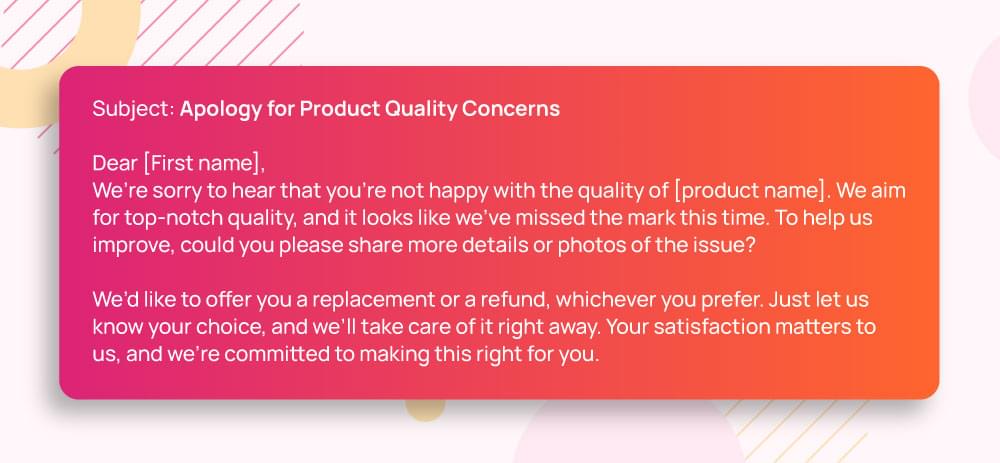
Billing Errors Template
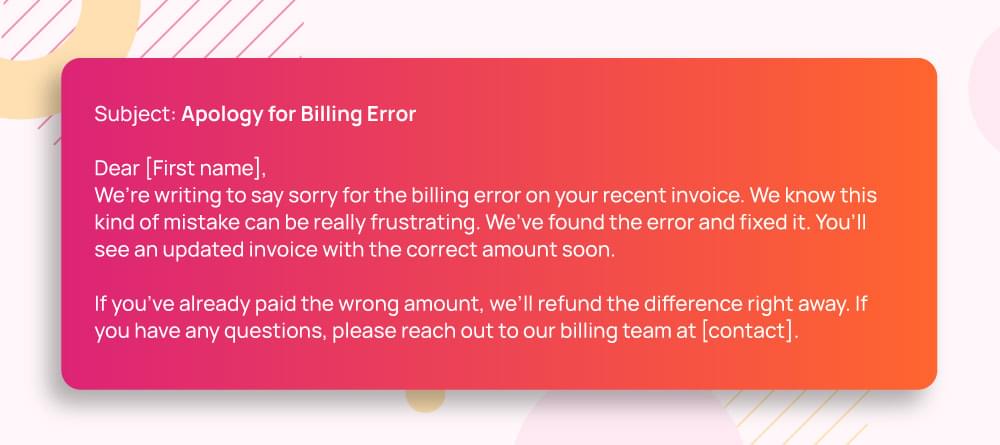
Poor Service Experience Template
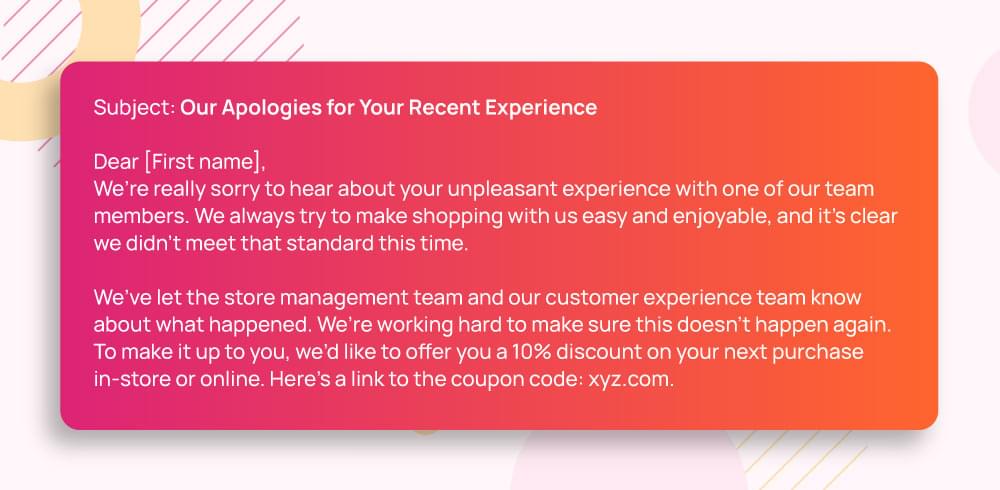
Technical Difficulties Template

Conclusion
Every time you communicate with an angry client, it is a perfect opportunity to learn something new. To enhance your customer retention strategies, you should consider subscribing to Churnfree.
FAQs
What are the main types of difficult customers and how can you effectively handle them?
There are five primary types of difficult customers:
- The Demanding/Bully/Aggressive Customer: This type of problem calls for decisiveness and clear idea of actions that can be taken.
- The Complainer: These customers need to be listened and understood as well as presented be multiple solutions.
- The Confused Customer: Offer to the point and simple information so that they can be able to make informed decisions.
- The Impatient Customer: Ensure that the timelines are well communicated and they are given updates on their query at each step.
- The Know-it-all Customer: Take their word but if they are wrong then correct them in a polite manner.
How to handle an irritate customer through email?
To calm an irritated customer via email, consider using empathetic phrases such as:
I know you are angry, I would be as well in this case.
This must be really annoying for you and I can only imagine how we went wrong here.
I understand that you are unhappy.
What do you do when a customer is rude or when they complain?
In such a situation, do not lose your temper and carefully construct your responses to the customers’ words. Do not be offended when they make their comments. Try to hear what they have to say in return and if the situation calls for it then say sorry. But do not be too soft when dealing with them because at times you may have to be firm.
What is the best way to end a conversation with a rude customer?
To end a conversation with a rude customer you need to let them know politely that their issue will be looked into and there’s nothing more that can be done in this situation. After that, you may say, ‘I don’t think there’s more to discuss,’ and end it.
Related Read:


